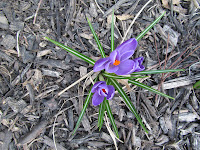Tuesday, April 16, 2013
10 a.m.
62 degrees Fahrenheit
It’s a gorgeous day today in Swissvale, PA. The sun is shining in a bright blue sky, the clouds are puffy white, the many different birds are singing and swooping to the bird feeders and back into the trees, more and more flowers are blooming, and this is just the beginning of spring.
Over the past months, my backyard has continued to amaze me. When I began this blog in January, I had a very surface relationship with my backyard. I really did not expect to find much nature, let alone much to write about, through the winter months. How narrow my view was of what thrived just outside my backdoor! Now four months later, I look forward to witnessing the various, sometimes subtle, sometimes shocking, changes that happen out here every time I take the time to look. And this has been the key for me to unlock the wonder that is the urban nature of my backyard: taking the time to look. Not just a cursory glance when the flowers are in full bloom or when a fresh blanket of snow has fallen, but to sit quietly and observe. To get up and examine the minutia up close. To write down these observations and then allow them to lead me to thoughts and connections I don’t think I would have otherwise made. Because of this project, I have discovered the joy of the nature journal and the lyric essay. I have also been pleasantly surprised by how many people have mentioned to me that they’ve been reading my blog.
 |
| Flowering pachysandra |
 |
| Narcissus x odorus: an heirloom daffodil |
The
surface relationship I had with my backyard at the beginning of this
project was similar to my familiarity with nature writing as a genre at
the beginning of this course. Although there are many natural images
that appear in my poems, I did not consider myself a nature poet
(although that is changing and I’m more confident in adopting such a
title). I did not have an understanding of the many ways one could
approach writing about nature. But there are as many ways to write about
nature and as many different stories to tell as there are versions homes and places to explore. There is much debate about what and
where nature is. To my way of thinking, this debate is lively and good
for the genre, good for writers, good for readers, and good for nature. There is room in the
genre for the gentle observations of a nature journal, the loud demands
of a rant, the complexities of a braided lyric essay, the magnifying
gaze of a poem, and all of the many other literary approaches tried and yet to be
tried. But why? Because nature is all around us (although that is
debatable). Nature is a part of us (although that is debatable). We are
nature (although that is debatable). Nature matters, no matter who you
are, whether you realize it or not. And it is the job of the nature writer to reach out and remind
everyone else that this is true.
 |
| Rosebush |
 |
| Easter hyacinth along the side yard |
 |
| Magnolia tree in our front yard |

















